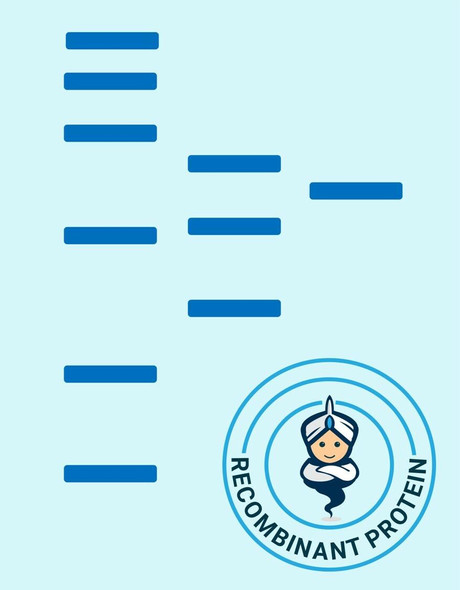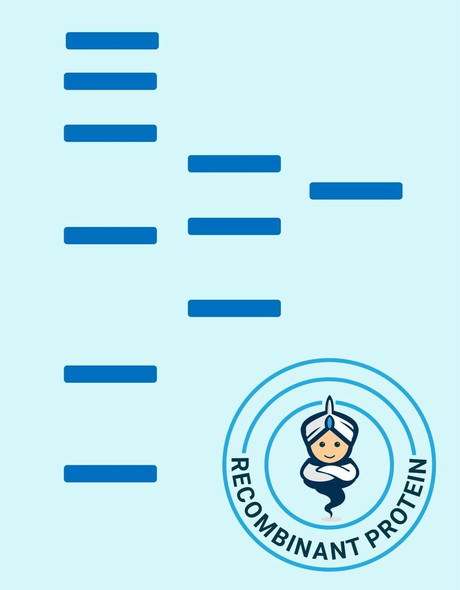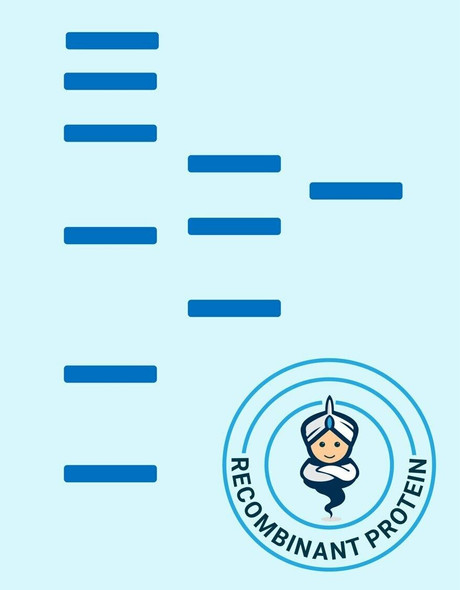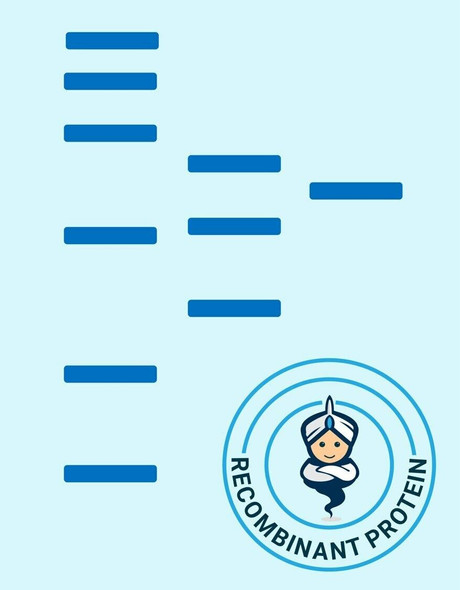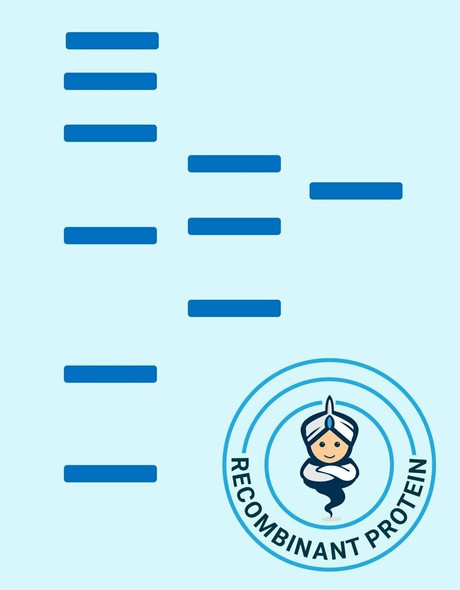Human IL 8 (1-77) Recombinant Protein (RPPB1166)
- SKU:
- RPPB1166
- Product type:
- Recombinant Protein
- Size:
- 50ug
- Species:
- Human
- Target:
- IL 8 (1-77)
- Synonyms:
- IL-8
- CXCL8
- Monocyte-derived neutrophil chemotactic factor
- MDNCF
- Source:
- Escherichia Coli
- Uniprot:
- P10145
Description
| Product Name: | Human IL 8 (1-77) Recombinant Protein |
| Product Code: | RPPB1166 |
| Size: | 50µg |
| Species: | Human |
| Target: | IL 8 (1-77) |
| Synonyms: | IL-8, CXCL8, Monocyte-derived neutrophil chemotactic factor, MDNCF, T-cell chemotactic factor, Neutrophil-activating protein 1, NAP-1, Protein 3-10C, Granulocyte chemotactic protein 1, GCP-1, Monocyte-derived neutrophil-activating peptide, MONAP, Emoctakin, K60, NAF, LECT, LUCT, 3-10C, LYNAP, SCYB8, TSG-1, AMCF-I, b-ENAP. |
| Source: | Escherichia Coli |
| Physical Appearance: | Sterile Filtered clear solution. |
| Formulation: | IL8 His is supplied in 10mM Tris-HCl pH 8, 250mM NaCl and 50% glycerol. |
| Stability: | Store at 4°C if entire vial will be used within 2-4 weeks. Store, frozen at -20°C for longer periods of time. Please avoid freeze thaw cycles. |
| Purity: | Greater than 95.0% as determined by SDS-PAGE. |
Interleukin-8 (IL-8) is a chemokine produced by macrophages and other cell types such as epithelial cells. It is also synthesized by endothelial cells, which store IL-8 in their storage vesicles, the Weibel-Palade bodies. When first encountering an antigen, the primary cells to encounter it are the macrophages who phagocytose the particle. Upon processing, they release chemokines to signal other immune cells to come in to the site of inflammation. IL-8 is one such chemokine. It serves as a chemical signal that attracts neutrophils at the site of inflammation, and therefore is also known as Neutrophil Chemotactic Factor.
Interleukin-8 Human Recombinant produced in E.Coli is single, a non-glycosylated, Polypeptide chain containing 77 amino acids fragment (23-99) and having a total molecular mass of 13.7kDa with an amino-terminal hexahistidine tag. The IL-8 His is purified by proprietary chromatographic techniques.
| UniProt Protein Function: | IL8: IL-8 is a chemotactic factor that attracts neutrophils, basophils, and T-cells, but not monocytes. It is also involved in neutrophil activation. It is released from several cell types in response to an inflammatory stimulus. IL-8(6-77) has a 5-10-fold higher activity on neutrophil activation, IL-8(5-77) has increased activity on neutrophil activation and IL-8(7-77) has a higher affinity to receptors CXCR1 and CXCR2 as compared to IL-8(1-77), respectively. Belongs to the intercrine alpha (chemokine CxC) family. 2 isoforms of the human protein are produced by alternative splicing. |
| UniProt Protein Details: | Protein type:Secreted, signal peptide; Cytokine; Secreted; Motility/polarity/chemotaxis Chromosomal Location of Human Ortholog: 4q13-q21 Cellular Component: extracellular space; extracellular region Molecular Function:protein binding; chemokine activity; interleukin-8 receptor binding Biological Process: regulation of cell adhesion; neutrophil chemotaxis; neutrophil activation; negative regulation of G-protein coupled receptor protein signaling pathway; unfolded protein response; calcium-mediated signaling; chemotaxis; signal transduction; regulation of retroviral genome replication; induction of positive chemotaxis; G-protein coupled receptor protein signaling pathway; negative regulation of cell proliferation; cellular protein metabolic process; unfolded protein response, activation of signaling protein activity; response to molecule of bacterial origin; receptor internalization; immune response; angiogenesis; cell cycle arrest; cell motility; inflammatory response; embryonic gut development |
| NCBI Summary: | The protein encoded by this gene is a member of the CXC chemokine family. This chemokine is one of the major mediators of the inflammatory response. This chemokine is secreted by several cell types. It functions as a chemoattractant, and is also a potent angiogenic factor. This gene is believed to play a role in the pathogenesis of bronchiolitis, a common respiratory tract disease caused by viral infection. This gene and other ten members of the CXC chemokine gene family form a chemokine gene cluster in a region mapped to chromosome 4q. [provided by RefSeq, Jul 2008] |
| UniProt Code: | P10145 |
| NCBI GenInfo Identifier: | 124359 |
| NCBI Gene ID: | 3576 |
| NCBI Accession: | P10145.1 |
| UniProt Secondary Accession: | P10145,Q6FGF6, Q6LAE6, Q96RG6, Q9C077, Q9UCE1, Q9UCR8 Q9UCR9, Q9UCS0, B2R4L8, |
| UniProt Related Accession: | P10145 |
| Molecular Weight: | 11,338 Da |
| NCBI Full Name: | Interleukin-8 |
| NCBI Synonym Full Names: | chemokine (C-X-C motif) ligand 8 |
| NCBI Official Symbol: | CXCL8 |
| NCBI Official Synonym Symbols: | IL8; NAF; GCP1; LECT; LUCT; NAP1; GCP-1; LYNAP; MDNCF; MONAP; NAP-1 |
| NCBI Protein Information: | interleukin-8; emoctakin; interleukin 8; T-cell chemotactic factor; neutrophil-activating peptide 1; beta-thromboglobulin-like protein; granulocyte chemotactic protein 1; tumor necrosis factor-induced gene 1; alveolar macrophage chemotactic factor I; monocyte-derived neutrophil chemotactic factor; monocyte-derived neutrophil-activating peptide; small inducible cytokine subfamily B, member 8; lymphocyte derived neutrophil activating peptide; lung giant cell carcinoma-derived chemotactic protein; beta endothelial cell-derived neutrophil activating peptide |
| UniProt Protein Name: | Interleukin-8 |
| UniProt Synonym Protein Names: | C-X-C motif chemokine 8; Chemokine (C-X-C motif) ligand 8; Emoctakin; Granulocyte chemotactic protein 1; GCP-1; Monocyte-derived neutrophil chemotactic factor; MDNCF; Monocyte-derived neutrophil-activating peptide; MONAP; Neutrophil-activating protein 1; NAP-1; Protein 3-10C; T-cell chemotactic factorCleaved into the following 7 chains:MDNCF-aAlternative name(s):GCP/IL-8 protein IV; IL8/NAP1 form I |
| UniProt Gene Name: | CXCL8 |
| UniProt Entry Name: | IL8_HUMAN |



